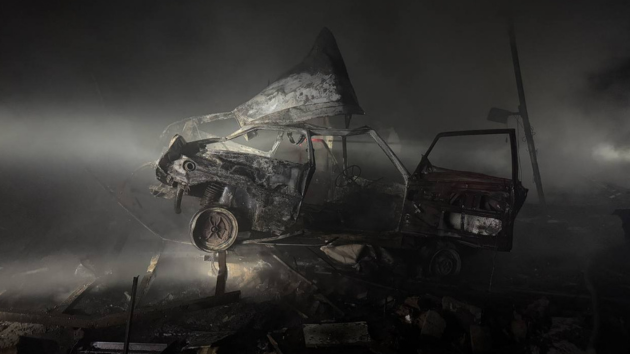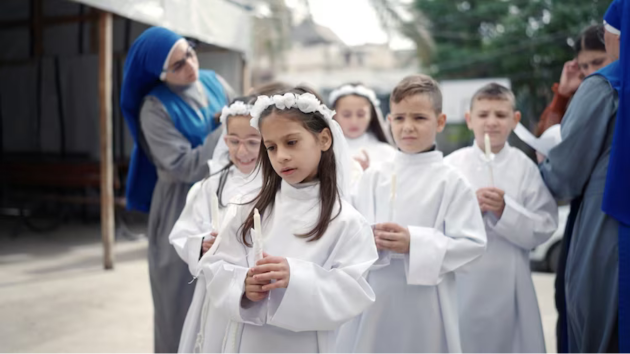ABC News analysis: 70% of schools in Gaza destroyed or damaged during Israel-Hamas war
Written by ABC Audio All Rights Reserved on September 13, 2024

(LONDON) — — Qadira Zourob, a 17-year-old in Gaza, was in her last year of high school when war broke out in the Strip after the Oct. 7 Hamas attack on Israel in 2023.
“I was preparing for my exams with great excitement. I had been studying hard, staying up late every night, determined to succeed and achieve a high score. But the next day, we woke up to the sounds of bombings and rocket fire,” she told ABC News in an interview in a tent where her family has been displaced.
Zourob is one of the more than 600,000 students in Gaza who have had their education interrupted by the war. She said she dreamed of becoming a nurse, helping people and traveling abroad, but now she says she feels lost, adding, “I feel as if my life has come to a standstill.”
As millions of children go back to school around the world, formal education continues to be on hold for the children of Gaza. An ABC News visual analysis reveals that at least 70% of all schools in Gaza — 399 school buildings — have been damaged or destroyed since Oct. 7.
In a statement to ABC News about these figures, the Israel Defense Forces said “There is no IDF policy to target schools or educators. Rather, Hamas’ widespread and well documented strategy of exploiting schools and educational facilities for terror activities, has required IDF activity in those areas.”
Using Palestinian Authority government and U.N. records, ABC News geolocated nearly every school in Gaza, about 547 of the 567 school buildings. Analysis of dozens of satellite images identified which of each of the 547 buildings were damaged or destroyed.
To further supplement the data, 149 videos where schools were visible, showing about a quarter of all schools, were added to the analysis. The videos were filmed by the IDF and Hamas, as well as dozens of local journalists, civilians, the United Nations, and other organizations in Gaza. Some schools that did not look damaged on satellite imagery had holes in the sides or the structures were still standing but lower floors had been completely blown out.
The results show 212 schools are either partially or completely destroyed, and a further 187 show signs of damage.
This analysis relies solely on data available online, as international journalists are not allowed into Gaza and movement for ABC News’ local journalists in Gaza is severely restricted.
The U.N. estimates as many as 84% of schools — 477 buildings — will need to be repaired or rebuilt. This higher number is a result of the U.N.’s use of a model to estimate blast damage to areas in the vicinity of bomb sites, while ABC News’ analysis relies solely on visually verifiable damage.
It has been a particularly bloody summer at school buildings across Gaza. At least 354 people were killed in Israeli airstrikes on school buildings that housed displaced people between June 1 and Sept. 1, according to individual tallies released by the Hamas-run Gaza Ministry of Health and collated by ABC News.
The death toll comes from Israeli airstrikes on 25 schools for which Israel has publicly claimed responsibility in that timeframe. In statements announcing the strikes, the IDF said each time that it was targeting Hamas militants or Hamas command centers embedded inside the school buildings. In statements on 23 of the 25 schools hit, the IDF said it took “numerous steps to mitigate the risk of harming civilians.”
Verified videos from 14 of the 25 scenes show injured and bloodied children either running or being carried from the wreckage.
A video taken by journalist Talal Mahmoud at the Abu Oreiban school in Nuseirat on July 14 shows six children being rushed out of the courtyard, as screams come from the school. A screaming toddler covered in dust sits against a back wall in another video. Twenty-two people were killed in the strike, according to the Ministry of Health.
The Khadija school, in the Israeli designated safe zone in Deir al-Balah, was struck on July 27. Video moments after the strike by a bystander, and verified by ABC News, shows dozens of people running from the school courtyard, carrying people, including multiple children, from the scene. As a child looks at the smoking ruins, another missile crashes to the ground, exploding on impact.
The entire eastern side of the school crumpled. Thirty people, seven of whom were children, were killed, according to the Ministry of Health. Video filmed by journalist Hani Abu Rezeq from the scene shows a young man with a biohazard bag picking up charred fragments of human remains from the rubble.
Future obstacles for educators, students
Rachael Cummins, a humanitarian director in Gaza for Save the Children, told ABC News the organization is bringing learning back to some of Gaza’s children. They started earlier this year with child-friendly spaces for play, and are now introducing more learning, with the goal of reintroducing a level of normalcy and structure to children’s lives, she said.
Cummins said the obstacles are immense, from staff safety, to finding child friendly spaces, to sourcing materials, and all made more difficult by the constant displacement of people.
For the children themselves, Cummins said, returning to learning is no easy task and the lost year will have lasting ramifications.
“Children haven’t been able to access formal education, so they’ve missed a whole year of learning. But, you know, outside of that, what they’re seeing and what they’re living through and the consequences of that in terms of their mental health, really, really cannot be underestimated. A whole generation, a whole population, actually, of children and their parents and their caregivers, in terms of the impact of the war on their mental health is absolutely extraordinary,” she said.
She said their programs have to take into account how the war has changed children’s behaviors, from finding it impossible to focus, to aggressive reactions, and anxiety attacks.
She also highlights the poor physical health, malnutrition and illnesses affecting many children in Gaza, which compound the difficulty of their focusing on anything but immediate needs.
“It’s a dire situation for children. It manifests in many different ways and is deeply distressing for them and obviously deeply distressing for their families who obviously want to support their children as best they can and to keep them safe, but it’s impossible,” Cummins told ABC News.
Qadira Zourob, the high school student, said her former school, in Khan Younis, is being used as a shelter for thousands of displaced people. It is damaged, but it has not been bombed. Even so, she said she does not have hopes she will be able to return to education, even if a cease-fire is agreed to.
“The displaced people will likely remain in the school. How can they be removed when they have no shelter, home, or anything else?” she asked.
“Our lives are on hold. What will become of my life?” she said. “An entire year of my life, where I built my hopes and dreams, has been destroyed.”
Copyright © 2024, ABC Audio. All rights reserved.

 KVSP
KVSP 




